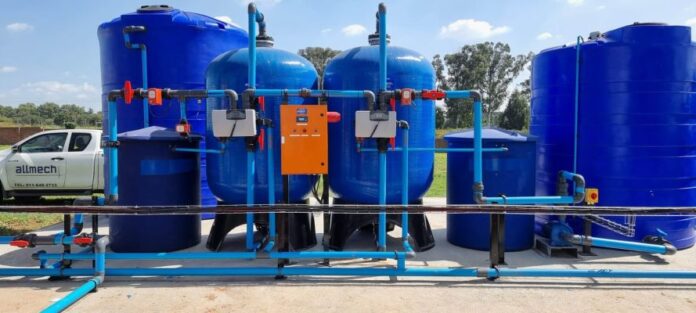Demineralisation plants are installed to remove dissolved solids (total dissolved solids or TDS) and mineral ions from feedwater and process streams. The typical use of ion exchange is to offer near-total removal of ionic mineral contaminants. When a vegetable oil extraction plant in Gauteng decided to investigate using borehole water to supply its boilers to cut down on municipal water costs, a demineralisation plant was the best option to reduce the high TDS to avoid extra boiler blowdowns being required.
Allmech, a leading South African manufacturer of boilers and supplier of water treatment components, was called in to install the demin plant. The customer then decided to use the water to supply the entire factory instead of just the boiler. Allmech was able to change some parameters on the demin plant to get closer to this requirement.
JP Thyse, Technical Manager at Allmech, explains that the quality of the boiler make-up water determines the boiler operating efficiency. “With this customer request, we designed a demineralisation plant using our new in-house PLC design, which allows customisable programming of various inputs. It also offers alarm functionality to flag when water quality isn’t up to standard, which ensures the water is not needlessly dumped through backwashing and alerts the user to potential issues,” he says.
The second key consideration for Allmech was which control valve would be best suited for this application. “The Runxin control valves are demand-initiated controllers that allow an efficient regeneration cycle to be completed within the cation and anion vessels,” says Thyse. “Once the treated water quality reaches the set point, the system will do a few checks and should the water remain outside specification, the plant will go into a regeneration cycle.”
Thyse says the cation vessel will regenerate first with the following sequence: backwash; acid draw and slow rinse; fast rinse; and return to service. “Once the cation unit has completed the regeneration cycle, the anion vessel will start its regeneration following the same sequence,” he says. Once the anion unit has completed the regeneration cycle, the plant returns to service mode and is ready to provide treated water. Should the water quality not be within specification after the regeneration process, the unit will rinse and reassess the output quality. If the water is still not within the required specification, a second regeneration will be initiated.
“I designed the plant making use of 48×72 FRP vessels with Runxin F77A3 Softener automatic control valves,” says Thyse. “During the initial installation and commissioning, issues arose as the initial mineral water analysis changed. Investigations were carried out, tests were conducted and adjustments were made to the initial plant design, reducing the TDS and increasing the pH. We changed both the hydrochloric acid for the cation resin and the sodium hydroxide for the anion resin solution.”
Thyse says Allmech initially tried different chemical ratios to regenerate the resins to help reduce backwash time to bring down the pH quicker for the treated water. “But this didn’t work because it only reduced the amount of treated water that the plant could supply,” he says. “The borehole water quality had changed drastically over the last year and halved the capacity of what the plant could produce from the original design specs.”
Due to changes in site conditions, the regeneration cycle times had to be changed to get maximum efficiency out of the demineralisation plant. “We realise the importance of training and maintaining the system with operating staff, showing them how to change program parameters, where to test the water, and how to undertake fault finding.”
Thyse adds that it’s important for customers to know that borehole water needs to be tested at least twice a year and possibly more, depending on volumes used. “Borehole water quality can fluctuate quite quickly and should be taken into account when doing the original assessment of the plant requirements to avoid unnecessary upgrades or required changes due to the change in water quality, depending on its use.









[…] Source link […]
Comments are closed.